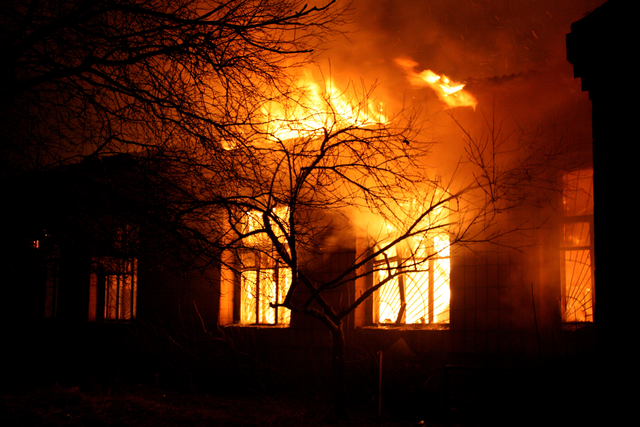Whether you live in wildfire country or you’re a volunteer firefighter, pay special attention to the tires on your primary vehicle. No tire can handle the hottest fires, but properly maintained tires are more likely to help you escape during an evacuation or sudden wildfire flare-up.
Pay attention to key areas of your tires and wheels during fire season. Always keep your vehicle ready to go with the six tips below.
1. Choose Tires for Your Terrain
Your family’s escape vehicle or your personal fire-response truck needs fresh tires that are designed for the terrain you travel. If you live or work in hilly, rocky terrain, have your tire service install all-terrain tires on your fire-season ride.
In raging wildfires, flames and embers sweep over roadways, and main routes out of neighborhoods become blocked. All-terrain tires help you navigate over gravel, mud, and debris along the sides of roads.
2. Use a Vehicle With High Clearance
When you have all-terrain tires on a vehicle with high enough clearance, you’re able to go further off road to get past dangerous sections of flaming roadway. High-clearance vehicles include trucks, SUVs and other vehicles with tire-rims at least 15-inches in diameter.
High-clearance vehicles also provide at least 8 inches of space between the road and the bottommost part of the vehicle’s frame. A high-clearance vehicle with adequate all-terrain tires can safely roll over small fallen trees, low ditches, rock piles and other off-road obstacles.
A high-clearance vehicle with two-wheel drive can safely make it down most two-wheel-drive roads. Many government roads are unmaintained four-wheel-drive paths. You need a high-clearance vehicle with four-wheel-drive capabilities to navigate these rocky roads in the event of wildfire outbreaks in the area.
3. Understand the Weight Limitations of Tires
Your tires can be safe enough to help you navigate on an ordinary day yet ill-equipped to carry your fully packed or outfitted vehicle. When you purchased your last vehicle tires, you may have purchased tires that are insufficient for the loads you must haul during fire season.
Stay ahead of fire threats by installing tires rated for the extra weight of evacuation or firefighting equipment. The tires on your fully loaded car or equipment-stuffed pickup are less likely to blow when the tires are designed to carry the extra weight. Double-check your owner’s manual to ensure your vehicle’s suspension and engine can manage the extra payload.
Have your tire service check out the tires on your trailers and campers if you plan on using the vehicles during an evacuation or fire response. The last thing you need in an emergency situation is a rotted trailer tire.
4. Keep Tires Inflated Properly
Your new tires last longer when you keep them properly inflated. Both under inflation and over inflation cause excessive wear on tires. Under-inflated tires can separate over time due to stress. Separation happens because the sidewall and tread on under-inflated tires move too much when rolling.
Overinflated tires lose traction because the shape of the tire is distorted. Overinflated tires develop wear on the sides of the tread, and eventually on the center tread as well. Both under and overinflated tires are subject to burst when you add air or change the tires.
You need to understand the proper tire inflation for your tires, vehicle, and trailers. Keep a tire gauge in your glove box at all times so you can check tire pressure at any time. The correct inflation of tires will give you a safer, more comfortable ride at any time of the year.
5. Use Uncovered Steel Wheels for Maximum Safety
During a fire emergency, your most important goal is staying out of harm’s way. Cars built with steel and adequate firewalls are less likely to ignite. Cars built with magnesium and aluminum can burn or melt completely in a raging fire.
Aluminum melts somewhere close to 1,200 degrees Fahrenheit. Vulcanized tires are not prone to ignite until temperatures reach around 750 degrees Fahrenheit. You’d have to be stuck in a bad fire for a long time to have your aluminum wheel covers melt or your tires catch fire.
However, firefighting experts recommend using steel wheels without covers on any firefighting vehicles. Aluminum or other decorative covers can hide rusted rims and worn lug nuts. Leave the fire-resistant steel wheels openly visible to make any necessary tire changes and safety checks easier to perform.
6. Use Your Common Sense
Your tires can only do so much to carry you to safety. In any emergency, stay aware and mindful of all dangers around you. Do not attempt to drive blindly into fire, smoke, or flooded roads. Bring chocks to secure your vehicle on hilly or unstable terrain.
Always make room to carry a spare tire when evacuating or responding to a fire. Practice changing a tire quickly, so you won’t panic if a flat tire happens during a crisis. Stock your vehicle’s trunk or pickup bed with an appropriate jack, tire iron, lug wrench, flares, safety cone and other tools for a complete tire change.
Contact Evans Tire & Service Centers today to install the safest tires on your evacuation and fire-response vehicles. We have the know-how and products to provide you with safe and durable tires for all of your driving needs.

